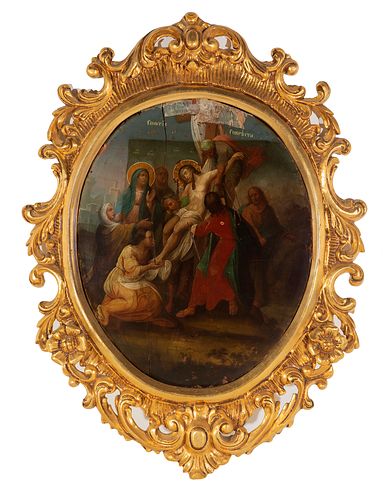Russian school of the XIX century. "Descent from the Cross". Oil on panel. Frame of the twentieth century. Size: 53 x 42 cm; 83 x 58 cm (frame).
Lot 123
About Seller
Setdart Auction House
Carrer Aragó 346
Barcelona
Spain
Setdart Subastas was born in 2004 and is currently the first online art auction in Spain with solidity, prestige and reliability guaranteed by our more than 60,000 users. Setdart has a young, dynamic and enterprising team ready to successfully manage the purchase and sale of art works through custom...Read more
Estimate:
EUR€2,000 - EUR€2,500
$2,040.82 - $2,551.02
Absentee vs Live bid
Two ways to bid:
- Leave a max absentee bid and the platform will bid on your behalf up to your maximum bid during the live auction.
- Bid live during the auction and your bids will be submitted real-time to the auctioneer.
Bid Increments
| Price | Bid Increment |
|---|---|
| EUR€0 | EUR€10 |
| EUR€200 | EUR€25 |
| EUR€500 | EUR€50 |
| EUR€1,000 | EUR€100 |
| EUR€3,000 | EUR€200 |
| EUR€5,000 | EUR€500 |
| EUR€10,000 | EUR€1,000 |
| EUR€20,000 | EUR€2,000 |
| EUR€50,000 | EUR€5,000 |
About Auction
By Setdart Auction House
Nov 3, 2021
Set Reminder
2021-11-03 08:00:00
2021-11-03 08:00:00
America/New_York
Bidsquare
Bidsquare : OLD MASTERS
https://www.bidsquare.com/auctions/setdart-auction-house/old-masters-7786
Setdart Auction House sofia@setdart.com
Setdart Auction House sofia@setdart.com
- Lot Description
Russian school of the XIX century. "Descent from the Cross". Oil on panel. Frame of the twentieth century. Size: 53 x 42 cm; 83 x 58 cm (frame). In this panel we see the scene of the descent from the cross of the dead body of Christ. Although it belongs to the Russian school of the XIX century, it is an Italian Baroque composition, close to the models established by Vladimir Borovikovski in the Russian Empire at the end of the XVIII century and the beginning of the XIX century, determined by its great scenographic and narrative sense. Formally, the work shows a marked hieratism, and manifests a special predilection for orthodox aesthetics in the golden decoration of the nimbuses. The treatment of light, which especially affects the figure of Christ, illuminating the main scene, responds to the knowledge of western baroque painters. The contained gesture of the characters, however, denotes a formation close to the academicist guidelines that prevailed in some painters of the Russian Empire at the end of the 18th century and the beginning of the 19th century. Each of the figures has been chiseled as a living sculpture, so that they occupy a resounding place in space, acquiring a variety of postures, foreshortenings and displaying studied choreographies. Iconographically, the figures of Joseph of Arimathea and Nicodemus stand out, vigorous personages who unclaim and support Christ; the three Marys, who remain in the background, withdrawn in mournful expressions and gestures; the effigy of the dead Christ descending from the cross, with a perfectly defined anatomy, free of a deep pathos, and St. John the Evangelist who, with his back to the spectator, offers his help to pick up the body of the Savior. The work is contained in a 19th century frame of great decorativism, worked in carved and gilded wood.
- Shipping Info
-
In-house shipping available. Please inquire at admin@setdart.com.
-
- Buyer's Premium



 EUR
EUR CAD
CAD AUD
AUD GBP
GBP MXN
MXN HKD
HKD CNY
CNY MYR
MYR SEK
SEK SGD
SGD CHF
CHF THB
THB















